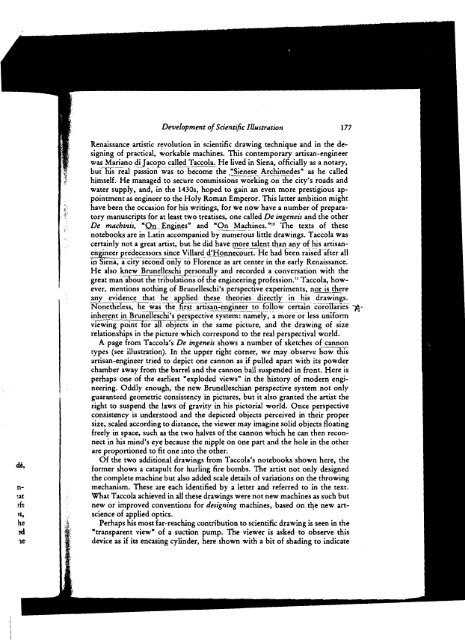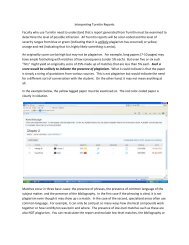The Renaissance Development of the Scientific Illustration - Winthrop
The Renaissance Development of the Scientific Illustration - Winthrop
The Renaissance Development of the Scientific Illustration - Winthrop
You also want an ePaper? Increase the reach of your titles
YUMPU automatically turns print PDFs into web optimized ePapers that Google loves.
<strong>Development</strong> <strong>of</strong> Scientijic <strong>Illustration</strong><strong>Renaissance</strong> artistic revolution in scientific drawing technique and in <strong>the</strong> designing<strong>of</strong> practical, workable machines. This contemporary artisan-engineerwas Mariano di Jacopo called Taccola. He lived in Siena, <strong>of</strong>ficially as a notary,~~~~~~Teal passion was to become <strong>the</strong> .'Sienese -_ Archimedes" - _____ as he calledhimself. He managed to secure commissions working on <strong>the</strong> city's roads andwater supply, and, in <strong>the</strong> 1430s, hoped to gain an even more prestigious appointmentas engineer to <strong>the</strong> Holy Roman Emperor. This latter ambition mighthave been <strong>the</strong> occasion for his writings, for we now have a number <strong>of</strong> preparatorymanuscripts for at least two treatises, one called De ingeneis and <strong>the</strong> o<strong>the</strong>rDe machtnis, 'fi.Bn&nesn and 'On Machines."Io - <strong>The</strong> texts <strong>of</strong> <strong>the</strong>senotebooks are in Latin accompanied by numerous little drawings. Taccola wascertainly not a great artist, but he did have -- more talent than any <strong>of</strong> his artisanengineerpredecessors since Villard cfHonnecoun. He had been raisihiifter all'ip Siena, a city second on$ to ~loience as art center in <strong>the</strong> early <strong>Renaissance</strong>.He also knew -- Brunelleschi -- - -- .- personally -- - and recorded a conversation with <strong>the</strong>great manxout <strong>the</strong> tribulations <strong>of</strong> <strong>the</strong> engineering pr<strong>of</strong>ession." Taccola, however,mentions nothing <strong>of</strong> Brunelleschi's perspective experiments, nor is <strong>the</strong>reany - evidence -------- that - he applied - <strong>the</strong>se <strong>the</strong>ories directly in his drawings.--- ___-~x<strong>the</strong>less, he was<strong>the</strong> - first artisa~engineer to f$ow certain coroITaries %-inherent in Brunelleschi's perspective system: namely, a more or less uniformviewing point for all objects in <strong>the</strong> same picture, and <strong>the</strong> drawing <strong>of</strong> sizerelationships in <strong>the</strong> picture which correspond to <strong>the</strong> real perspectival world.A page from Taccola's De ingeneis shows a number <strong>of</strong> sketches <strong>of</strong> - cannontypes (see illustration). In <strong>the</strong> upper right corner, we may observe how thisartisan-engineer tried to depict one cannon as if pulled apart with its powderchamber away from <strong>the</strong> barrel and <strong>the</strong> cannon ball suspended in front. Here isperhaps one <strong>of</strong> <strong>the</strong> earliest 'exploded views" in <strong>the</strong> history <strong>of</strong> modern engineering.Oddly enough, <strong>the</strong> new Brunelleschian perspective system not onlyguaranteed geometric consistency in pictures, but it also granted <strong>the</strong> artist <strong>the</strong>right to suspend <strong>the</strong> laws <strong>of</strong> gravity in his pictorial world. Once perspectiveconsistency is understood and <strong>the</strong> depicted objects perceived in <strong>the</strong>ir propersize, scaIed according to distance, <strong>the</strong> viewer may imagine solid objects floatingfreely in space, such as <strong>the</strong> two halves <strong>of</strong> <strong>the</strong> cannon which he can <strong>the</strong>n reconnectin his mind's eye because <strong>the</strong> nipple on one part and <strong>the</strong> hole in <strong>the</strong> o<strong>the</strong>rare proportioned to fit one into <strong>the</strong> o<strong>the</strong>r.Of <strong>the</strong> two additional drawings from Taccola's notebooks shown here, <strong>the</strong>former shows a catapult for hurling fire bombs. <strong>The</strong> artist not only designed<strong>the</strong> complete machine but also added scale details <strong>of</strong> variations on <strong>the</strong> throwingmechanism. <strong>The</strong>se are each identified by a letter and referred to in <strong>the</strong> text.What Taccola achieved in all <strong>the</strong>se drawings were not new machines as such butnew or improved conventions for designing machines, based on <strong>the</strong> new anscience<strong>of</strong> applied optics.Perhaps his most far-reaching contribution to scientific drawing is seen in <strong>the</strong>'transparent view" <strong>of</strong> a suction pump. <strong>The</strong> viewer is asked to observe thisdevice as if iu encasing cylinder, here shown with a bit <strong>of</strong> shading to indicate












